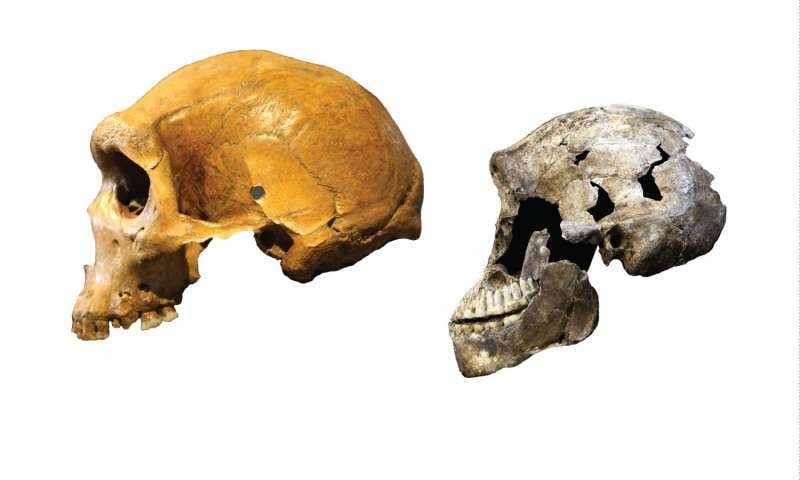Ancient Human Cousin May Have Lived Alongside Early Homo Sapiens
Homo naledi may have been much younger—and more advanced—than previously thought
/https://tf-cmsv2-smithsonianmag-media.s3.amazonaws.com/filer/66/cd/66cd846a-fab0-4bea-bd20-804c04624e6e/neo_skull.jpg)
In 2013, researchers mounted an expedition to Rising Star Cave in South Africa’s Cradle of Humankind World Heritage Site. There—in a room called the Dinaledi Chamber—the team found the remains of another ancient human relative: Homo naledi. The enigmatic creature had a brain the size of gorilla’s and a strange combination of features from both modern and early hominins. Even more, the excavation yielded a massive haul: 1,500 fossils from 15 individuals.
Since then, scientists have tried to puzzle through where H. naledi fits in the human family tree—or whether it belongs there at all. Now, three papers published in the journal eLife are beginning tease apart the story of the species. This trio of studies focus on two primary topics: dating the original H. naledi specimens and documenting the discovery of a second chamber full of H. naledi remains. As Sarah Kaplan reports for The Washington Post, the results suggest that this human cousin is both surprisingly young and could have exhibited a range of advanced behaviors, including the use of tools and burying their dead.
One of the papers addresses dating the original H. naledi bones. Since the samples were so old, it was not possible to date them directly or extract DNA, Kaplan reports. Instead, the researchers had to rely on dating the sediments the bones were found in—not an easy undertaking since the cave has periodically flooded over the centuries and the layers of dirt were complex. To accomplish this task, the team worked with 10 different laboratories and institutions around the world using six different techniques, according to a press release. This test determined that the original H. naledi bones are startlingly young—dating between 335,000 and 236,000 years ago.
The new age raises the possibility that H. naledi could have lived alongside modern humans in Africa, which emerged roughly 200,000 years ago. Previous studies have sugggested that other species of hominins including Neanderthals, a mysterious group known as the Denisovans and Homo floresiensis, aka the hobbits, all existed on Earth at the same time as modern humans. This new study, however, suggests that another hominin may have overlapped with ancient human ancestors.

The two other studies document the discovery of over 130 H. naledi bones, which researchers believe belong to three individuals—one of which could be the most complete fossil hominin ever found. “With the new fossils from the Lesedi Chamber...there are more Homo naledi specimens than any other extinct species or population of hominins except for Neanderthals,” John Hawks of the University of Wisconsin and lead author of the paper on the bones, says in a release.
These latest fossils hail from a second cavern in the Rising Star cave system, dubbed the Lesedi Chamber, about 300 feet from where H. naledi was first uncovered. In the researcher's analysis of these bones, however, they make some controversial claims. The researchers speculate that the age of the bones could mean that H. naledi could have made some of the South African stone tools previously attributed to early humans. But aside from wrist and fingertip similarities that H. naledi share with Neanderthals and modern humans, there is little evidence that the species could make tools.
The researchers also suggest that the location of the bodies deep in the Cave is an indication that H. naledi purposely buried their dead. Lee Berger, the lead scientist at the University of Witwatersrand in Johannesburg, tells Ian Sample at The Guardian that the discovery of second chamber backs up the idea. "I can’t see any other way [for the bodies to get there], other than them going into these remote chambers themselves and bringing bodies in," he says. If true, it would also mean H. naledi could have also mastered fire in order to navigate the deep, dark cave.
But the interpretations should be approached with caution. Alison Brooks of the Smithsonian’s Human Origins Program tells Kaplan she’s not yet convinced, pointing out that in the past the cave could have been more accessible or there could have been a hole where bodies were dropped. It’s also possible that floods washed the bones into the caverns.
Regardless of if these implications hold true, the fossils suggest that human history is much more complicated than scientists once believed. “You can’t tell simple stories anymore,” Berger tells Sarah Zhang at The Atlantic. “This is the gigantic message out of Homo naledi.”
Rick Potts, director of the Human Origins Program at the Smithsonian Institution's National Museum of Natural History, expresses similar sentiments about the find to Kaplan at The Washington Post, suggesting we dispose of the idea of linear evolution from chimp to modern human. “We've had for so long this view that human evolution was a matter of inevitability represented by that march, that progress,” he says. “But now that narrative of human evolution has become one of adaptability. There was a lot of evolution and extinction of populations and lineages that made it through some pretty tough times, and we're the beneficiary of that.”
Some of the H. naledi fossils will go on display at the Cradle of Humankind World Heritage Site visitor’s center in Maropeng, South Africa beginning May 25.